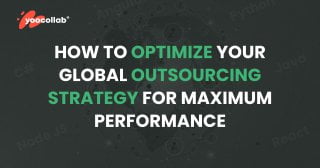In today’s interconnected world, the strategic importance of global outsourcing cannot be overstated. Companies across the globe are leveraging outsourcing to improve efficiency, reduce costs, and gain access to specialized skills and innovative technologies. However, not all outsourcing efforts lead to success; the difference often lies in the strategies employed. This article explores effective global outsourcing strategies that can help organizations maximize their outsourcing performance and achieve substantial competitive advantages.
Understanding Global Outsourcing
Global outsourcing involves delegating business processes or functions to external companies, possibly in another country, to capitalize on benefits such as lower labor costs, superior expertise, and improved focus on core business activities. This strategic move can encompass everything from manufacturing to software development, customer service, and back-office support.
The Need for a Strategic Approach
A strategic approach to global outsourcing is crucial for its success. Organizations need to align their outsourcing initiatives with their overall business goals and operational strategies. This alignment ensures that outsourcing contributes directly to the enhancement of performance and achievement of strategic objectives.
1. Define Clear Objectives
The first step in optimizing your global outsourcing strategy is to clearly define your objectives. What do you hope to achieve through outsourcing? Common goals include cost reduction, access to skilled labor not available locally, scaling operations quickly, and enhancing service quality. Objectives should be specific, measurable, achievable, relevant, and time-bound (SMART).
2. Choose the Right Outsourcing Model
Selecting the appropriate outsourcing model is critical. The three primary models are:
- Project Outsourcing: Best suited for specific, one-time projects with well-defined requirements and deadlines.
- Dedicated Team: Ideal for ongoing work, where the outsourced team acts as an extension of the in-house team.
- Managed Services: Useful for delegating entire business functions, where the outsourcing provider manages the process end-to-end.
Each model has its benefits and challenges, and the choice will depend on your project needs, management capacity, and long-term business strategies.
3. Select the Right Partner
Choosing the right outsourcing partner is one of the most critical decisions in the outsourcing process. Criteria for selection should include:
- Expertise and Experience: Ensure the vendor has proven experience in the specific area you are outsourcing.
- Cultural Fit: Consider language, time zone, and cultural differences that might impact collaboration.
- Technology and Infrastructure: Verify that the partner has the necessary technology and infrastructure to meet your project requirements.
- Financial Stability: Partner with firms that are financially stable to avoid disruptions in your service delivery.
4. Focus on Communication and Collaboration
Effective communication is the backbone of any successful outsourcing relationship. Establish clear communication channels and protocols. Regular updates, meetings, and feedback sessions help in maintaining transparency and alignment with project goals. Utilizing collaborative tools and technologies can enhance interaction and ensure that everyone is on the same page.
5. Implement Strong Governance Structures
Strong governance structures are essential to monitor the outsourcing relationship and ensure that it remains in alignment with business objectives. This includes setting up clear metrics for performance evaluation, regular oversight, and mechanisms to address any issues that arise. Governance should be a joint effort between the client and the provider to foster a partnership rather than a transactional relationship.
6. Manage Risks Proactively
Outsourcing, particularly on a global scale, comes with its set of risks, including political instability, fluctuations in currency exchange rates, and differences in legal systems. Conduct thorough risk assessments and develop contingency plans to address potential issues. Data security, particularly with GDPR and other privacy regulations, should also be a top priority.
7. Cultivate a Relationship of Trust
Building a relationship of trust with your outsourcing partner can transform the traditional client-vendor relationship into a strategic partnership. Trust is built through transparency, shared goals, and mutual respect. Over time, this trust can lead to greater innovation and efficiency, as partners are more willing to invest in the relationship’s success.
8. Continuously Improve and Innovate
The global market is continually evolving, and so should your outsourcing strategy. Regular reviews and feedback allow for continuous improvement and innovation. Stay informed about industry trends and advancements, and be open to adapting your approach to stay ahead of competitors.
9. Measure and Analyze Performance
Regularly measuring and analyzing the performance of your outsourcing initiatives is vital to ensure they are delivering the desired outcomes. Use key performance indicators (KPIs) and benchmarks to evaluate success and identify areas for improvement. This data-driven approach helps in making informed decisions and further optimizing the strategy.
Conclusion
Optimizing your global outsourcing strategy is not a one-time effort but a dynamic, ongoing process that requires attention, adaptation, and continuous improvement. By following these strategies, companies can maximize the benefits of global outsourcing, turning it into a powerful tool for business growth and innovation. The key is to approach outsourcing thoughtfully and strategically, ensuring it aligns with your company’s overall goals and operational needs.
In conclusion, as global markets become more competitive and complex, the ability to effectively manage and optimize global outsourcing strategies becomes increasingly important. By carefully planning and implementing these strategies, organizations can achieve not only cost efficiencies but also enhance their capabilities and market responsiveness.
For example, Yoocollab offers an array of business solutions designed to help companies better understand and optimize their international operations.
With the right team on board, you can be sure that your global outsourcing process is running as smoothly as possible – effectively guaranteeing a higher return on investment in the long run!
As always, research before taking any leap – even if it’s a good one – and don’t forget the power of collaboration when utilizing an outsourcing strategy.
With these simple steps and tips, you will be well on your way to optimizing your global outsourcing strategy!




